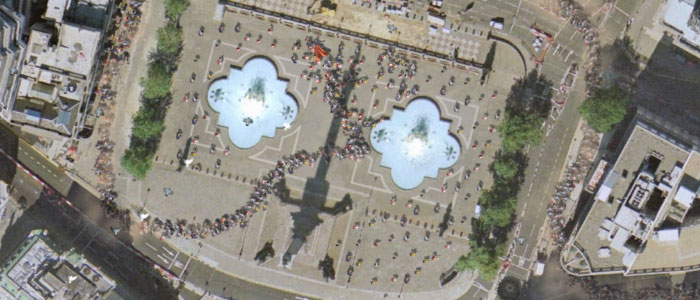The agoraphobic await rescue from you.
From Hindustan Electronics Co., the quirky title The Last Guy’s Google Maps exterior only hints at the wacky fun inside. The story goes that Earth is attacked by a purple ray that transforms the populous into zombies, with the exception of the agoraphobic. Those survivors are holed up in the buildings of major cities awaiting rescue from you, the chosen one – The Last Guy!
Armed with a blue suit, red cape, and the ability to occasionally sprint you are tasked with saving the human race on behalf of the United Rescue Force. You lead the uneasy masses toward Escape Zones, where they will be airlifted to safety. Your efforts target fifteen cities, San Francisco, Berlin, and London among them, each recognizable due to the developer’s ample use of satellite imagery. You play top-down with the desperate race occurring in alleys, highways, docks and parks as you battle against the clock to rescue a pre-determined number of civilians.
Controls are clean and simple – the left analog controls your direction, the right the camera and the right triggers the zoom level. Thermography display, X, presents the humans as green blobs, reveals hidden paths and allows you to see the otherwise invisible Chameleon Zombies – but hides all others. Triangle increases speed and Circle summons the herd to bunch up close to you. Both speed and gathering people require stamina, which is gauged in the aptly named Stamina Meter on the lower left of the screen. The meter’s capacity grows with your line, and will refill over time or with the acquisition of energy boosting power-ups. Other power-ups include stopping zombie activity, invisibility, and a warp that returns you to an area near an Escape Zone.
The creatures in The Last Guy aren’t your average slow-moving, decapitation is the only way zombies. More like monsters each has different powers; certain “Normal Zombies” and a few other staples are present in nearly every level and each stage tends to focus on one specific, extra tricky Zombie type. Among them, the Mold Zombie which grows and bubbles towards you, the fast-moving Bug Zombie which skitters across the screen, and the Stalker Zombies which are slow moving creatures that more than strongly resemble Cousin It and will follow you everywhere once you’re in their sights.
The use of specialized zombies for each level in tandem with the very detailed maps keep the challenge fresh, as does the incentive to make your line as long as possible. Strategy is indispensable as different maps and zombies call for different measures – not every stage tolerates a huge line, others demand them and time is always a challenge. The zombies will give chase to your and your line of fleeing citizens on sight. They don’t devour them so much as scatter them into the nearest building, which is lucky since it can be hard enough to round up 1500 survivors without them being taken out of play. Thus, the trick becomes hiding a line of 1500 people in an alleyway because in spite of your special “chosen one” status, you are pretty darn vulnerable.
This arcade-style gameplay is polished off with a touch of whimsy. The music is as lively as the humor and the game’s limited tracklist isn’t so much redundant as it is anthemic. In addition to the game’s tributes to the days of 8-bit little touches make it good fun – like when the line of people screams and shakes the controller anytime a zombie approaches. The menus are perfection, and while the whole package may not be delivered with next-gen graphics the presentation is unquestionably solid. My primary complaint (other than the lack of Trophies) is that it was difficult to decipher what was onscreen on more than one occasion. The game is by no means easy, and in general I didn’t mind; the exception was dying just because somewhere between couch and screen all visual clarity was lost (or the zombie was under a tree).
With fifteen levels the first run-through of the game will likely span a day or so, with plenty of replayability. Beyond just wanting to save more people in a stage and increase your score for the leaderboards, each city has four hidden VIP’s. Typically in harder to reach sectors, the VIP’s are worth bonus points which count toward your final score and your star count. If you are skilled enough to achieve three stars in each level of a set, a secret stage is unlocked making a total of four additional stages.
The Last Guy has a definite personality and style that almost completely overcomes the fact that it doesn’t exactly make use of “the power of the Cell”. It may not pack a graphical whollup, but it is more than just a novel idea. With truly addicting gameplay and a healthy portion of silliness, saving major cities from zombies is hours of fun.
